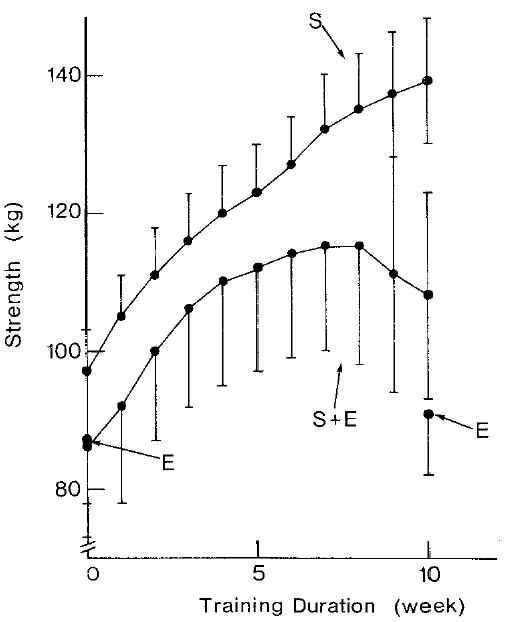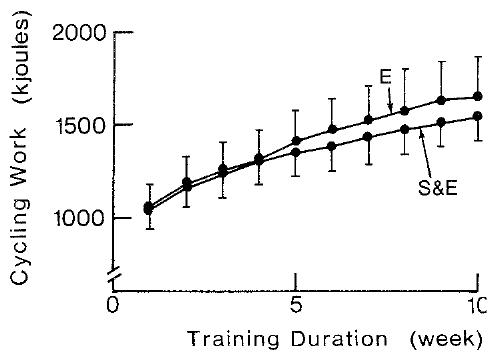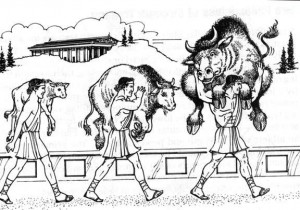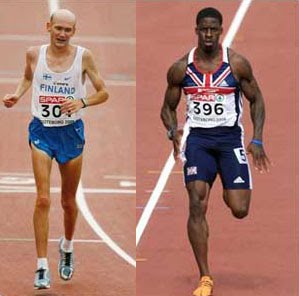Lesson 1. Milo of Croton
Every day since a very young age, Milo would drape his calf over his shoulders and do his daily exercises. As his calf grew, so did Milo’s strength. Many years passed and by the time of the Olympic games, Milo’s calf had become a full-grown bull and Milo’s strength became unparalleled in all the land (or so the story goes).
This is how strength-training works. Increasing the amount of weight you lift progressively, consistently, and frequently makes you stronger.
Lesson 2. Concurrent training
Resistance training builds muscle and strength. Endurance exercise is good for the heart, burns fat and muscle, but doesn’t make you stronger. Endurance exercise hinders the gains reaped from resistance exercise, not vice versa. Interpretation: runners should lift; lifters shouldn’t run (sprints don’t count).
In what has become IMHO a classic best-of-all-time paper, Bob Hickson single-handedly combined and took apart these lessons with one wonderfully simple experiment. For background, see HART-D trial: aerobic, resistance, or both?
Interference of strength development by simultaneously training for strength and endurance (Hickson, 1980)
3 interventions, healthy young adults.
1. Strength training program: 3 days per week of heavy leg exercises:
On alternating days: squats (3×5), knee flexions (3×5), and knee extensions (3×5); and leg presses (3×5), calf raises (3×20). On days 2 & 4 they did deadlifts and situps to strengthen their core and thus prevent injury.
2. Endurance training program: it was equally intense.
3. Concurrent training program: both strength and endurance training programs. Yes, both.
Results: 1) strength trainers gained the most muscle (+1); 2) endurance trainers lost the most weight (-1, see marathon runner above); and 3) endurance training blunted the increase in muscle seen in strength trainers way more than the fat loss seen in endurance trainers in those assigned to concurrent training (-1).
Interpretation: WRT body composition, concurrent and endurance training produced similar results.
What about functional outcomes?
1) The strength trainers got way stronger (+1, see Lesson 1).
2) Endurance training improved endurance but blunted strength gains in concurrent trainers (-1, see Lesson 2).
3) Not surprisingly, endurance trainers gained endurance but didn’t get any stronger (-1).
BUT, strength training didn’t appreciably impact endurance in concurrent trainers (LESSON 2!)!
Furthermore, strength training alone didn’t improve endurance, but more importantly, it didn’t impair the increase in VO2max seen in concurrent trainers.
This study is beautiful in its simplicity. If your goal is to optimize performance in your respective sport the answer is clear: runners should lift; lifters shouldn’t run. Lifting heavy weights won’t impair running performance but it will make you less weak.
This experiment needed no follow-up, but a more recent study provided a unique insight into the gray area of endurance training-like effects of high repetition light weight resistance exercise.
Molecular adaptations in response to three different resistance-training regimens: specificity of repetition maximum training zones (Campos et al., 2002)
3 groups, each doing leg presses, squats, and knee extensions.
1) Low reps: 3-5 reps per set, 4 sets, 3 minute rests (most representative of lifting heavy weights)
2) Intermediate: 9-11 reps per set, 3 sets, 2 minute rests
3) High reps: 20-28 reps per set, 2 sets, 1 minute rests (most similar to endurance training)
The amount of weight lifted was progressively increased so that each set was performed to near failure throughout the duration of the study.
Results: similar to the differences between strength and endurance training seen in Hickson’s study, lifting heavy weights at low reps improved strength (“1RM [kg]”), whereas lifting light weights for a lot of reps improved endurance (“Repetitions”):
If your goal is to get stronger, lift heavier and heavier weights; additional endurance training might improve your cardiovascular system but will hinder strength gains. If your goal is endurance: run, cycle, or lift light weights for a lot of reps; and also lift heavy weights so you don’t get soft. Milo once broke a metal band placed on his head by furrowing his brow. He ate 20 pounds of meat and drank 18 pints of wine daily; indeed, Milo scoffed at “moderation.”



